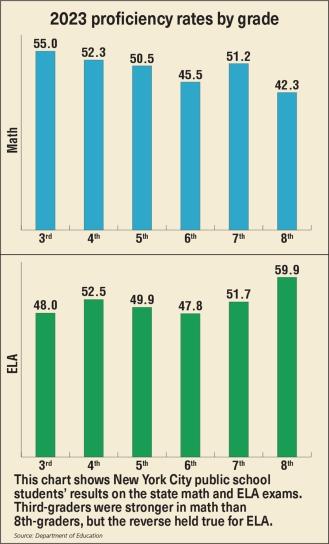Half of NYC kids passed state tests

About half of New York City’s 3rd- to 8th-grade students are proficient in math and reading, according to the scores on the spring 2023 state tests.
The results are not directly comparable to the previous year’s because the 2023 tests were overhauled to reflect the state’s Next Generation Learning Standards, but there is reason for optimism. About 50% of students showed proficiency in math on the spring 2023 test, a 12-point rise from the 2022 exam, and nearly 52% of students were proficient in reading, an almost 3-point jump.
“We applaud all the hard work our students and educators did in the past year,” UFT President Michael Mulgrew said. “While increases in standardized test scores get all the attention, we know the work educators and students do can’t be captured in a single test score. Educators are preparing students for their future. That’s the scope of the work our educators are doing every day.”
The 2023 results, which were released in October, provide insight into how students are mastering the state’s Next Generation Learning Standards. They were not uniform across grades. Third-graders performed better in math than 8th-graders: 55% of 3rd-graders are proficient in math versus 42.3% of 8th-graders. However, 59.9% of 8th-graders were proficient in ELA versus only 48% of 3rd-graders.
The achievement gap between Black and white students narrowed by 2% in math and 2.2% in ELA.
However, significant disparities persist. In math, 77.6% of Asian students and 70.2% of white students are proficient, compared with 34.3% of Black students and 35.7% of Hispanic students. In ELA, 72.3% of Asian students and 69.5% of white students are proficient versus 40.3% of Black students and 39.4% of Hispanic students.
Children with greater needs continue to struggle on these exams. Only 24.4% of students with disabilities are proficient in math versus 56.9% of general education students. In ELA, 21.7% of students with disabilities were proficient compared with 60.2% of general education students.
Of current English language learners, 21.5% are proficient in math and 11.1% are proficient in ELA.
In an interesting finding, students who are categorized as “Ever ELLs,” meaning students who are not now categorized as English language learners but were at some point in their schooling, outpaced their “Never ELL” counterparts.
Of “Ever ELLs,” 69.6% are proficient in math compared to 53.5% of their “Never ELL” counterparts. In ELA, 69.3% of “Ever ELLs” are proficient in ELA versus 55.9% of “Never ELLs.”